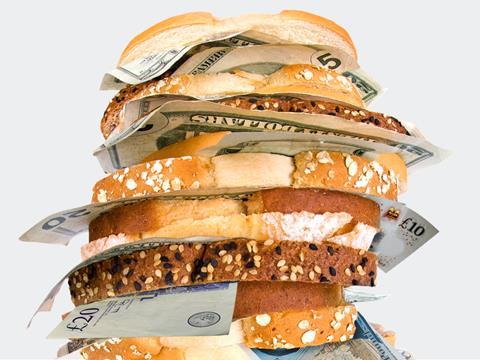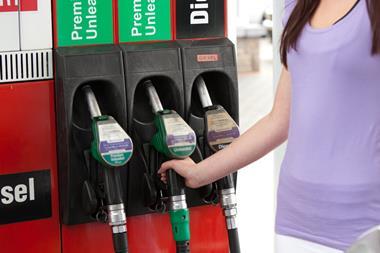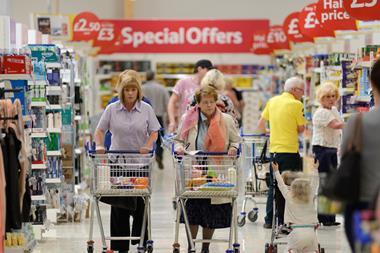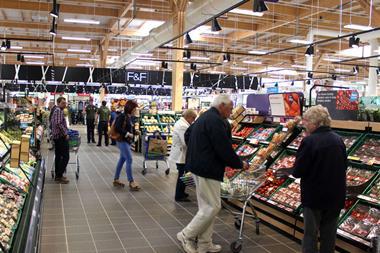
The relationship between buyers and suppliers has always been symbiotic, even if it hasn’t always been harmonious. Although some of the brutal buying tactics have softened, spats like Marmitegate show tension still exists.
A Marmitey microcosm of Brexit, the stand-off between Unilever and Tesco in 2016 was fuelled by the weakened pound causing the supplier to hike its prices by 10%. And as Brexit draws closer, threats of rising costs across groceries make familiar news stories.
Long before products appear on supermarket shelves, managing commodity costs earlier in the supplier chain can have a knock-on effect on the rsp. So how are stakeholders dealing with pressures like Brexit, prospective US tariffs and supermarket mergers?
“There are some real issues,” says Stefan Vogel, head of agri commodities at Rabobank. “The dispute between the US and China impacts several commodities. And if you compare the currency in the UK to pre-Brexit levels, it’s tanked from £1.40 to £1.12 versus the euro. That means a sizeable increase for the price of commodities, so UK processors pay higher prices.”
It doesn’t help that the commodities market is already “volatile” to begin with, says Tom Lawrence, director at commodity price risk experts Flow&Ebb. “There is a wide basket of commodities and in the last 12 months most of them swung by 30% to 60% between the highest and lowest price. So the norm is volatility, and if you bring in Brexit, the level of volatility increases.”
What are the drivers of volatility?
Whether it’s commodities currently considered high risk, like wheat, barley, fruit, veg, meat, dairy, cocoa, cod or olive oil, all agricultural food and drink commodities are subject to volatility and it’s difficult to make any predictions about how any of them will swing. But it is safe to say the drivers affecting them are many.
Tom Lawrence, from commodity price risk experts Flow&Ebb, says Donald Trump’s US trade war creates several areas of concern, such as the potential for Mexico to buy 10 times more corn from Brazil, a decline in US pig parts to China, and South Africa and the US fighting over poultry as a result of the steel and aluminium tariffs. That means the markets are adjusting to constant change, creating “much more risk in trading with the US, driving decisions in a different direction”.
Then there’s the weather, which went infamously haywire in the UK and further afield during the summer, with temperatures nudging record levels. That meant low grass production leading to higher dairy prices, and low wind generation generating higher gas prices for storage for the winter.
Plus there’s hurricane season in the US and the regular prospect of El Niño. “Weather changes are some of the biggest drivers on price, specifically forward prices, in commodities,” warns Lawrence. And there’s the environment in general, he adds, with the tougher stance on carbon credits pushing carbon prices to new highs.
Meanwhile Iranian sanctions have led to high oil prices, with Opec unable to fill the shortfall in a classic case of high demand meeting a low supply. The resulting high oil prices are creating higher transportation costs on all commodities.
And, of course, there is Brexit. “Businesses are weighing up the probability of ‘no deal’ and what that means,” says Lawrence. And any deal is “likely to leave most things unchanged and risk premia dissipates. Alternative sources will be assessed, there will be short-term risk which may drive some stockpiling, if that’s even possible. But the main driver of Brexit that will affect commodities is currency. Products which trade in sterling versus euros will be affected. And the risk premia on imports and exports is substantial until some clarity is created on what the future looks like.”
Everyone wants that clarity to happen soon. But it’s not all bad if you’re a canny trader, he adds. “Any uncertainty creates volatility. Whether it’s Brexit, the weather or trade wars, all equal uncertainty. And volatility equals both an opportunity and a threat, depending on how you manage the price risk it creates.”
And if you bring in the prospect of a no-deal Brexit, things go beyond volatile.
“If the UK crashes out of the EU with nothing, there will be significant consequences,” says Hans Frode Kielland Asmyhr from the Norwegian Seafood Council. “Seafood is a time-sensitive commodity, so any delays at British ports will impact quality.”
Brexit is “bad enough but the prospect of a no-deal is scary”, says Chris Ormrod, MD of The Flavourworks. “We can buy butter anywhere in the world, but if I buy from outside Europe it comes with WTO trade tariff pricing, which is a 40% tariff on butter.”
To put that in context, he says: “I spend £3m a year on butter, buying 600,000 kilos. A WTO tariff would mean an additional £1.4m. So I’d have to increase my prices to customers by 10%. And I’m just buying butter for my little business in Somerset - if I was Dave Lewis or Mike Coupe I’d be thinking ’holy s**t’…”
20%
The amount by which the value of the pound has fallen against the euro since the referendum in June 2016
2.7%
The highest inflation recorded on supermarket prices since the referendum vote two years ago
39%
The proportion of UK food imported in 2017, according to the NFU - and thus most vulnerable to price changes
$250bn
The value of tariffs imposed by the US on Chinese products in the past year. President Trump has threatened $267bn more
£51bn
The combined sales of Asda and Sainsbury’s, which announced their merger in April along with the promise of a 10% price cut on 1,000 lines
And it’s not just eye-watering tariffs that will cause problems for commodities.
“Theresa May dropped a time-bomb on the food and drink industry,” he says. “My business employs 50% EU nationals. Not having them any more is going to be an absolute killer to parts of the UK food and drink industry. We are heavily reliant on low-skilled pairs of hands. At the moment we’re OK, but it’s about what happens in four years. If I had to add another 10% on to my labour costs, that’s 1% on my bottom line to recover, and the food industry will pass it on to the supermarkets who will pass it onto the customer. We enjoy some of the lowest food prices in the modern world, but we are going to have a shock to the system.”
With all this going on in the background, are negotiations between manufacturers and suppliers becoming more heated?
“No more heated than normal,” says Alex Waugh, director general of National Association of British and Irish Flour Millers. “The reason for that is there was a big commodity shock in 2007. Lots of commodity prices shot up and caught out a lot of manufacturers and retailers.”
The legacy for the commodity market has been “a tendency for sellers to keep a steady dialogue with their customers about what’s going on - it’s almost an advisory role alongside the normal negotiation of a contract. So while discussions are no less hard, everyone is aware of what’s going on. No one feels they have been pushed into something they were unaware of.”
Ormrod says there is a “general sense for me and my customers that we are all in this together. In the last three weeks there has been a real uptick in customers saying ‘please would you detail your plans for supplying us in the case of a hard Brexit’. It’s like the world of grocery has suddenly woken up. We’ve not been asked that before.”
In turn, he has done the same with his suppliers. “We aren’t negotiating on this, we are just laying out our plans, which include placing contracts for ingredients that cover the essential Brexit months of March and April next year, so I can guarantee supply. We have paid a small premium for that. But it will be nothing compared with what will happen if there is no deal.”
As for where the balance of power between retailers, manufacturers and suppliers currently lies, Lawrence says suppliers like Cargill and other big agri-producers have “a lot of capability to transfer risk down the supply chain because they have the most amount of knowledge. The manufacturers are definitely getting better at it, the supermarkets are behind them, but they also hold some power because they are big. The result is that manufacturers in the middle get squeezed.”
As ‘no deal’ Brexit looms, can Defra withstand the pressure?
Ormrod agrees “manufacturers take the most hits” but says while Cargill “are good, if you’ve got a product that doesn’t differentiate or you’re just passing it on in unprocessed form, you’re never going to be strong in that relationship. You may be big and powerful but if you’re one of 20 people that could supply the same product, you still need to be the best supplier in terms of costs. Those rules won’t change.”
If you are in a crowd, benchmarking against rivals can help a supplier stand out, says Rappor Metrics MD Duncan Curtis. “Unless you compare your B2B relationships with peers, you’re working in a bubble,” he says. “Even companies that consider themselves professional and structured cannot identify if they lead the category, or if their competitors are widening the gap or catching them up. The benefits of knowing and using this information, in granular detail, are clear.”
The “market leaders need to ensure they stay ahead, challengers need to prioritise where they focus their resources, and new disruptors need to target their limited resources where they know they can beat the established players, so they can deliver continuous marginal gains and measurable competitive advantage.”
“Competition between suppliers doesn’t really happen at the commodity level because pricing is so visible”
It’s even more important to gain those advantages now, because even if you leave future problems like Brexit or trade tariffs aside, Ormrod says the biggest issue for manufacturers and suppliers are those happening at the moment, like the mergers between Tesco and Booker or Sainsbury’s and Asda.
“Brexit is a pain, but most manufacturers we talk to are more worried about Mike Coupe’s much-vaunted threat to ‘shake the suppliers until some more money falls out of their pockets’. It’s like you’ve got Hurricane Brexit on the one side and Super Typhoon Supermarket Mergers on the other. It’s a perfect storm.”
Relationship strategies
But the hard-nosed tactics used by supermarkets in the past won’t work when it comes to commodities, says Flow&Ebb’s Lawrence.
“Wind the clock back 10 years when supermarket buyers were in a commanding position - they would come in and say ‘we’ve got some headwinds, as a supplier you have to sort that out’. It’s a trait they still have. But the more they buy a specific commodity, the more there is a transparent, market-led price. You can’t just turn around and say ‘the market is £500 a tonne, could you give it to me for £400 a tonne?’ The answer is ‘No, I can’t, I’m only ever going to sell it at the market price’.”
Saying “‘I’m a supermarket, I can cause you a headache’ doesn’t work when they’re dealing with suppliers that have big trading arms, like Cargill or FC Stone. The old school rule of procurement, where you go in with a club and demand a fixed price, is not how to buy a commodity. It requires a much more sophisticated approach - the customer and supplier are in it together.”
What everyone is trying to get away from is the “yo-yo effect, where someone might buy at the top of the market, then feel they have lost out and the producer has made super profits. Then the year after it’s all on the floor and the buyer has done fantastically well but the producer is struggling to turn a profit. That’s why the commodity market has developed the way it has.”
“Everyone knows what they are buying in terms of the product,” says Waugh. “The prices of commodities are quite transparent.” As a result, “price is not the be-all and end-all. Of course it’s a factor, but it’s about trying to strike a level in terms of price and other factors like location, reliability and service levels.”
Can Brexit still deliver a fair deal for food & drink?
The transparency of the market also means it’s difficult to play one supplier off against another. “Yes, it’s still a competitive market,” adds Waugh. “But it doesn’t really happen at the commodity level because pricing is so visible. If you’re a farmer you can check the market price of wheat any second of any day.”
The reality is “this is a much more grown-up relationship, and more of a trading relationship,” says Lawrence. “And the volatility of products like cocoa, butter and dairy is far in excess of the margin benefits you would get from moving from one supplier to another. So yes, a customer will go to a supplier and assess whether they can meet their physical demands, but what they are really trying to understand is whether a relationship can be formed to manage that commodity risk between them.”
It sounds positively harmonious compared with the histrionics of Marmitegate, but the general sense of positive co-operation can only be a good thing. Because in the infamously volatile and unpredictable world of commodities, the only safe prediction is that tough times are coming down the line.
How to negotiate a ‘pay rise’
Price rises can be a difficult subject. Here is advice fromDuncan Curtis , executive director at Rappor Metrics, on how suppliers can best work with manufacturers when discussing and negotiating cost changes.
Justification: Any price rise needs to be justified as scientifically as possible, meaning it needs to be backed up with as much relevant data as possible. For instance, the harvest of a particular commodity is down by 35% at source, but demand is growing by 3%, so there’s not enough of the product to go around, plus shipping costs are up 10%.
Category analysis: Reviewing the competitive product range in stores can add to the overall context. For instance, the major competitor is already 10% more expensive than us, or competitor ‘Y’ just put through a price increase. That way, your retail customer can see that the cost increase is justified.
Review of the processes involved: This should not just look at the cost increase but should explain to the customer that you have carried out a thorough review of all the relevant processes or logistical considerations involved in the product to see if the cost increase could be mitigated in any way. It should also explain any positive impacts you have found and how this affects the cost increase.
Managing the increase for the consumer (mainly controlled by brands rather than suppliers): There can be a massaging of the impact of any price increase to help the consumer by agreeing some sort of promotion or marketing campaign to support the product or range that will be increasing in price. For instance, the current retail price 99p, plus a cost increase of 10% will lead to rsp moving to £1.09, which triggers a product promotion of two for £1.99 after four weeks at new price. This could be supported by the supplier in question as well as the branded supplier who is dealing with the retailer.
Explore alternative options: You could consider pack size changes, recipe changes or switching supply to another source in a different location where costs are cheaper.
Commercial trade-off: Analyse the cost vs volume equation (or contract length) where the supplier can explain that if they can double their volume of the product or ingredient they can lower the cost increase by 25%.



















No comments yet